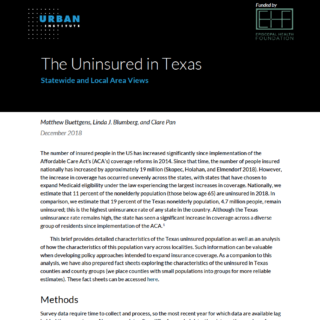Two-thirds of Texans without health insurance live in working families and more than half are in families that include at least one full-time worker. These are just some of the findings from The Uninsured in Texas, a detailed report written by Urban Institute analysts and sponsored by Episcopal Health Foundation.
Click on a local region above to see a detailed fact sheet with characteristics of the uninsured for that area.
The report shows that construction, wholesale and retail trades, and arts/entertainment/recreation each employ about 15 percent of the state’s uninsured workers. More than four in 10 (42%) uninsured Texans are in families with at least one adult who works at a company with more than 50 employees, the report finds.
“This report paints a clearer picture of who the uninsured are in Texas,” said Elena Marks, EHF’s president and CEO. “Many are Texans who work full time in stores, wait tables, build homes, or care for Texas toddlers, but they still don’t have access to affordable health insurance. And that effects all Texans.”
Researchers estimate that 19 percent of Texans under the age of 65 in Texas — 4.7 million people — don’t have health insurance. That remains the highest uninsured rate and the most people without health insurance of any state in the U.S.
The report finds that 60 percent of uninsured Texans live in low-income families earning less than $35,000 a year for a family of four. Researchers discovered that 25 percent of adult Texans under the age of 65 are uninsured, more than triple the rate of uninsured children in the state (8%). The difference is primarily due to the broader eligibility for public health insurance programs for the state’s children, researchers say.
When it comes to education, the report finds that about 70 percent of the state’s uninsured have a high school education or less. In fact, researchers found that roughly half of Texans without a high school diploma don’t have health insurance.
Statewide, the report shows that 61 percent of Texans without health insurance are Hispanic, compared to 24 percent white and 10 percent black. Researchers also found that nearly two-thirds of the uninsured in Texas are U.S. citizens.
In addition to the statewide report, researchers provide detailed characteristics of the uninsured broken down by counties and county groups across Texas. These local reports show how the uninsured populations differ in various areas of the state. For example, the area with the state’s highest uninsured rate is in south Texas in Hildalgo County at 30 percent. The lowest rate is in Collin County, north of Dallas, at 12 percent.
Researchers estimate that 15 percent of the uninsured under the age of 65 in Texas are eligible for Medicaid or CHIP health insurance. However, if Texas lawmakers expanded Medicaid or came up with an alternative plan to offer health insurance to low-income adults (earning up to $35,000 for a family of four), researchers estimate that 1.2 million uninsured Texans currently ineligible for assistance would be made eligible for free or very low cost coverage.
“Without policy changes, it’s likely that the number and share of uninsured Texans will increase with time,” said Linda Blumberg, Institute Fellow at the Urban Institute’s Health Policy Center and co-author of the report. “With health costs continuing to increase, it will make coverage less affordable for low-and middle-income residents and put more financial pressure on state government and healthcare providers.”
A recent EHF/Kaiser Family Foundation poll found that two-thirds of Texans said that the state is not doing enough to help low-income adult residents get needed healthcare, and the same majority favor expanding the state’s Medicaid program to cover more low-income adults.
“We can’t keep doing the same thing and expect more people to get coverage that’s affordable,” Marks said. “After years of some improvement under the Affordable Care Act, this report confirms that the state’s uninsured rate is still unacceptably high. Texans want lawmakers to do something different and now’s the time to do it.”
Methodology
The Uninsured in Texas: Statewide and Local Area Views provides an estimate of Texas’ uninsured population and key demographic characteristics using the Urban Institute’s Health Insurance Policy Simulation Model (HIPSM). The HIPSM offers a detailed microsimulation model of the coverage effects of the healthcare system. The HIPSM integrates data from the U.S. Bureau of Census’ American Community Survey, age projections, and enrollment and cost information from Texas Medicaid, CHIP and tax-credited Marketplace coverage to develop its state and local estimates.
